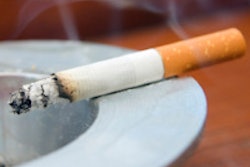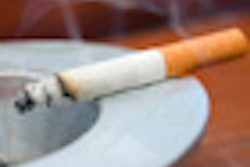
Many studies have reported that smoking can cause increased gingival pigmentation. But what about the effects in those who don't actually smoke but are exposed to it?
So-called "passive smokers" -- those exposed to secondhand smoke -- may be at risk, too, according to a new study that reports a correlation between environmental tobacco smoke (ETS) and gingival pigmentation (Journal of Periodontology, July 2011, Vol. 82:7, pp. 956-962).
Nonsmokers exposed to ETS absorb nicotine and other harmful compounds that can have side effects ranging from gingival pigmentation to lung cancer and even death, noted the study authors from the department of periodontics at the Bangalore Institute of Dental Sciences and Postgraduate Research Center in India.
There is limited documentation of gingival pigmentation in nonsmokers, and the existing information is "contentious," they added.
Study methodology
To assess the effects of ETS from smoker parents on gingival pigmentation in children and young adults, the researchers studied 153 nonsmoking children and young adults (age, 6-24 years) who had one or more parents who smoke; the patients were selected from the outpatient department of periodontics at the institute between December 2009 and May 2010.
The participants were divided into three groups based on age: group 1 was 6 to 12 years, group 2 was 13 to 18 years, and group 3 was 19 to 24 years.
The authors recorded the smoking history of the parents by interviewing both the study participants and their parents. Smoking history was recorded in pack-years (number of cigarettes per day multiplied by the number of years of smoking).
“The visible pigmentation effect in gingiva of children could be useful in terms of parental education.”
— Takashi Hanioka, DDS, PhD, Fukuoka Dental College
The researchers then took oral photographs with a digital camera and evaluated participants' degree of pigmentation using two examiners who were masked to the smoking status of the parent. Gingival pigmentation was assessed using the gingival pigmentation index (GPI):
- 0 = No pigmentation
- 1 = Solitary units of pigmentation in papillary gingiva without the formation of a continuous ribbon between solitary units
- 2 = One or more units of formation of a continuous ribbon extending from two neighboring solitary units
The researchers also conducted a urine analysis to assess levels of cotinine, a metabolite of nicotine, in the study participants.
Statistically significant findings
"The prevalence of gingival pigmentation in passive smokers was statistically significant," the authors reported. "Increased levels of urinary cotinine were observed in all three groups with the highest levels in group 3."
Even though the effects of parental smoking on the gingival pigmentation in children were noticeable, the extent of pigmentation was unclear, and additional studies using quantitative analyses could establish more strongly the association between melanin pigmentation in human gingiva and passive smoking, the authors noted.
"Melanin pigmentation is easily visible to the naked eye, and thus, the GPI can be used as a tool for parent education with respect to the harmful effects of tobacco smoke in children," the authors concluded.
Kwan-Yat Zee, BDS, from the faculty of dentistry at the University of Sydney, who has published a paper on the link between smoking and periodontal disease (Australian Dental Journal, September 2009, Vol. 54:3, pp. 44-50), said that while results of this study are "quite interesting," this sort of gingival pigmentation usually does not cause any harm, except that it does not look good aesthetically.
In Dr. Zee's opinion, the finding of increased levels of urinary cotinine is more important because it indicates the potential systemic impact of secondhand smoke. It may be more important for the medical colleagues to follow up such findings, he added.
Takashi Hanioka, DDS, PhD, from the department of preventive and public health dentistry at Fukuoka Dental College in Japan, has also investigated the relationship between gingival pigmentation in children and passive smoking (Pediatrics, August 2005, Vol. 116:12, pp. 186-190) and said the current study validates his study's findings.
"Excessive pigmentation in the gingiva of children is associated with passive smoking," wrote Dr. Hanioka and his co-authors. "The visible pigmentation effect in gingiva of children could be useful in terms of parental education."
Gingival tissue is very sensitive to tobacco smoking, although the underlining mechanism is still unknown in detail, Dr. Hanioka told DrBicuspid.com.
"Because gingival pigmentation is visible, this symptom is very valuable to motivate smokers to quit, although dental practitioners should keep in mind that factors other than tobacco smoke influence gingival pigmentation," he said.



















